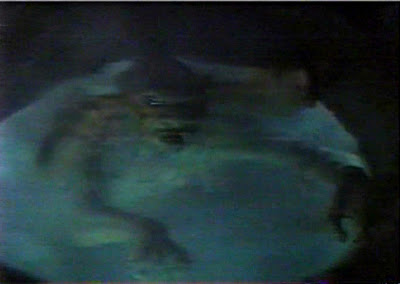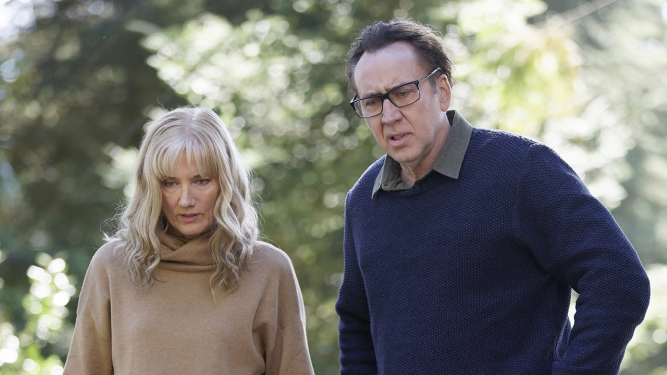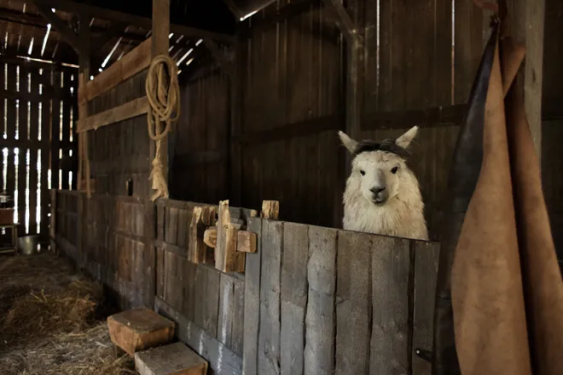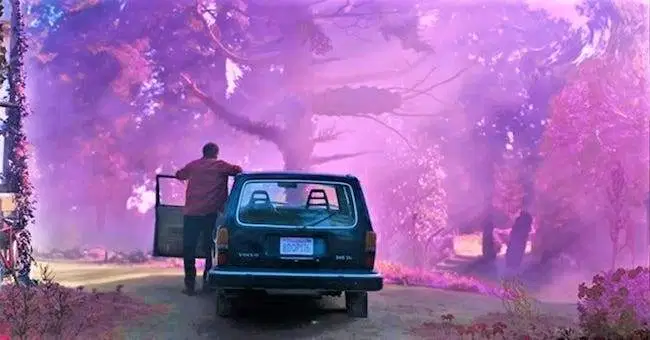A strength of the written word over visual media is that it can convey abstractions that extend or even violate literal description. In a comically broad example, a writer can tell you “To all outward appearance it was a happy scene—but horror lurked underneath!” (And when filmmakers do this, as in Blue Velvet, it can be just as ridiculously ham-handed.) Personally, I can seldom bring myself to watch filmings of Ray Bradbury stories because, in my mind, those stories are always wondrous and emotionally vibrant, and that seldom comes out on screen.
But in the area of abstraction, the Waukegan poet had nothing on the Providence patrician, Howard Phillips Lovecraft, who was fond of defining things in terms of impossibilities: Non-Euclidean geometry meaning “things that don’t conform to the laws of natural space”, sounds unlike any sounds a human could comprehend, and of course, weird alien colours (with the affected English spelling). And he managed (not always but often enough to persist over 100 years) to create a wondrous, weird, malignant universe with impossibly abstract visuals and a few choice details.
Which is damned hard to film. (I’m reminded of Adriane Lyne’s query to Bruce Joel Rubin over a script direction in Jacob’s Ladder: “The walls crack open revealing the unfathomable void.” Lyne asked him, “How many carpenters will it take to build the unfathomable void?”)

These days you could do it with a half-dozen doughy middle-aged dudes and a case of Monster.
Horror films generally are plagued by Joyce’s “ineluctable modality of the visible”—that’s an in-joke I’ll explain in the comments—but what I’m getting at is that the instant you show something, it becomes defined and you lose some of the horror. The original theatrical cut of Alien does an excellent job of teasing the alien, showing hints and having the human crew chase around clues that fill in the picture. Then, by the end, when you see it in all its glory, you’re suitably awed by it.
When the threat is known and clearly defined in a film, it becomes more an action/adventure picture no matter how many horror effects it borrows. The label “Survival Horror” sometimes get applied to such films, but one isn’t usually scared by, e.g., the Resident Evil movies. Or, say, Tremors, a fine film with a lot of suspenseful moments, but not scary. You can also contrast Alien to Aliens, or Night of the Living Dead to Day of the Dead. Particularly the latter: Zombies don’t even seem like much of a threat once you know their “rules”. But zombies are easy to do, and even Alien just needed a very tall, very skinny dude in an (excellently designed) rubber suit.
Now, get your costume designers on Yog-Sothoth:
“Imagination called up the shocking form of fabulous Yog-Sothoth – only a congeries of iridescent globes, yet stupendous in its malign suggestiveness.”
The very first (and still one of the best) adaptations of H.P. Lovecraft’s stories is Roger Corman’s The Haunted Palace, featuring said Yog-Sothoth. It recapitulates the mood of his successful, broody Poe stories, but with a somewhat different flavor, all to build up to one of the great cinematic disappointments:

It’s actually worse in the movie, as they do a “wavy vision” effect over this static picture, and you’ve been built up to something dramatically that’s…well, you feel like the movie—and the world—deserves better. (Coincidentally, Alien screenwriter Dan O’Bannon directed a version of this story in 1991.)
Five-hundred words is a lot of preamble for any movie review (though not my record) but I think it’s important to understand the mindset of the HPL fan in going to a mainstream-ish feature based on his works: You hope (without much hopefulness) that it manages to capture some of the characteristics of the writing and that it does so without some utterly embarrassing issue cropping up.
On that front, this movie is a resounding success. For the most part, the CGI reminds me of the Eastern movies we see: It’s not the best technically, but it’s not trying to fool you—it’s trying to win you over. So let’s get into the deets:
The story is updated from the sullen New England family to modern-day refugees from city life. This is savvy: Our characters are isolated by choice, and instead of being ignorant, moody farmers, they’re all-too-hip post-hippie homeschoolers. Another great aspect is that they’re not cartoon cutouts. Our scarcely involved narrator Ward (Elliot Knight) first meets daughter Lavinia—an irritable poseur—as she’s casting a spell that she hopes will take her out of the forest life but also will cure her mother’s cancer.
Nicholas Cage plays Nathan, who’s brought his brood back to the family farm, out of the city to a safe, sane place where you drink water from the well, grow organic produce, and emotionally support your financial wizard wife (Joely Richardson, The Patriot, The Girl With The Dragon Tattoo) who’s recovering from cancer, and raise your three kids who aren’t entirely sold on this whole hicksville thing. The movie does a good job getting you to like these people which, well, it’s kind of a shame what happens to them. (Contrast with the 1987 version of this story starring Claude Akins and Wil Wheaton, The Curse, or even the recent Annihilation.)

“What the HELL is that?”
What happens is that a meteor strikes their small farm. This is where we first get a taste of the movie’s regard for the source material: The meteor doesn’t just hit. There’s a build-up. Again, contrasted with other versions of the story (like the Creepshow entry “The Lonesome Death of Jordy Verrill”), director Richard Stanley infuses the scene with an alien intelligence. As such, when the horrifying transmogrification begins, the plot feels almost like a sci-fi invasion story. Tonally, this is spot-on: HPL’s universe was cold and hostile, and his monsters flew through (or lived in) the vacuum of space or sat at the bottom of the ocean for eons.
The aesthetic is also spot-on: Given the limitation of having to present an actual color, the choice of the sort of purple-pink never-occurs-in-nature oddly-saturated hue works well. The color shows up in glints and flashes everywhere, though more and more prominently as the poison from the well spreads. The family experiences the meteor differently as well, the two teenagers (played by Brendan Meyer and Madeleine Arthur, both of whom have appeared in R.L. Stine material in the past, amusingly enough) seem to be the least affected, though they experience time shifts/loss, while young Jack Jack (Julian Hiliard) seems to commune with the voices only he can hear coming from the well. Meanwhile Nathan is assaulted by a smell no one else seems to be able to detect and Theresa (Richardson) seems to be semi-possessed.
We won’t even go into the alpacas.

Concerned reader “Al” writes in to ask “WHY? WHAT HAPPENS TO THE ALPACAS?!”
A nice thing is that the characters’ behaviors are understandable. If I recall the original story, the transformation takes quite some time whereas here it happens in days. It’s not that everyone acts rationally—they are, after all, under the influence of a malignant space disease—but that you could see how a mildly diminished capacity would result in misunderstandings which result in fatal delays. So we are spared from the whole “Why don’t they just…?” syndrome common to horror films.
Some good spooky moments. No jump scares. A lot of disturbing things that felt Lovecraftian. Therese and Jack Jack have an encounter with The Color that is positively upsetting. A brief glimpse of an alien world. Another scene has Lavinia casting a spell by carving letters into herself with a box-cutter but you’re not sure whether this is the influence of the meteor or her attempt to fight that influence. A nice updating of the parental characters going mad: They start acting like their parents. (So to those who wonder, yes, Nic Cage does go crazy but it’s a different kind of crazy.)
One scene rips off John Carpenter’s The Thing which, if you’re going to steal, steal from the best. Tommy Chong has a role as paranoiac hermit Ezra (another rather savvy update to “the crazy old coot who lives in the woods” trope) whose exeunt is very effectively done. Producer Josh C. Waller (who also produced Mandy) plays a sheriff who, if I’m not mistaken, has a run in with a Shuggoth.

Prince lives.
I’m not sure about that one, but easter eggs abound: The narrator is a hydrologist from Arkham (the nearest big town) and wears a Miskatonic University shirt. He reads Algernon Blackwood’s The Willows, considered by HPL to be the finest horror in the English language. And his name is “Ward”. (I think they say “Philip Ward” at some point but I may have misheard that.) The weather report is for Arkham and surrounding cities like Dunwich and Innsmouth. The book Lavinia tries to cast her spell from is the Necronomicon, (but it’s the Necronomicon you can buy on Amazon, not HPL’s version). Fortunately, the references settle down as the action picks up.
The Boy and I had to catch it separately but we both agreed that we liked it, that it was solid, but no Mandy, a comment which isn’t meant derogatorily because I probably liked this more. As good as the atmosphere is in most respects, we couldn’t help but wonder if it might not have benefited from a little more of Mandy’s surrealism. Nonetheless, for a guy whose last feature directing job was being thrown off Island of Dr. Moreau 20 years ago, Richard Stanley has shown a very sure hand here and I’m looking forward to the next movie in the trilogy: The Dunwich Horror.
